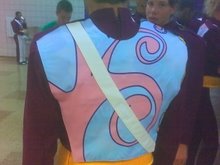Competition...Blessing or Curse? - Part 1 - Drum Corps (cont.)
This is the 5th installment of my series on Competition in Drum Corps - I encourage you to read the four previous installments found below...
_____________________________________
Educational Value
Drum Corps is an excellent educational tool for teaching a variety of things. What are some of the things that are taught? Musical excellence, Discipline, Physical excellence, and hard work are four that come to mind. So lets examine how competition affects each of these lessons. Also for consideration is the trickle down effect from having so many music educators marching in corps today.
Musical excellence -
As examined in the previous post, competition has driven corps to explore extreme musical complexities. The musicians that march today are, overall, more trained and have a better background in music than those who marched years ago. This is not a knock at the "old-timers", just an observation that it is quite difficult to obtain a spot in a highly competitive Drum Corps without having some serious training. Competition has directed the best musicians to the best corps, and left many casual musicians behind. Since the quality of musician has increased, the question is does the activity still have a musical educational value?
This influx of musical talent has actually increased the musical value of the activity. Since most of the performers are starting at higher levels, the corps can better explore musical nuances and spend time perfecting interpretation instead of fundamentals. Harder music, plus the ability to explore the music at deeper levels equals a high educational value in terms of musical excellence.
Discipline -
Here is another area that has been changed drastically from the beginnings of drum corps. The performers today are not local kids who are just looking for something to do over the summer, they are kids who choose to do this activity specifically. Everyone that marches wants to be there and generally try and help out their corps as much as possible. Discipline is not really a major issue these days. From my experience, though, I would say that all marchers learn a level of disciple they never thought possible - even the most dedicated learn something. This activity cannot be duplicated by anything else and nothing can really prepare you for the issues one has on tour. Going through the experience will, for sure, make someone more disciplined. Competition, by changing the main makeup of performers, has increased the value of learning discipline.
Physical Excellence -
This goes hand in hand with musical excellence. Competition has driven corps to perform more visually demanding shows. Performers are put through many varieties of physical training that rival many boot camps - from 2 mile running/breathing blocks, to strength training. Many performers now train in the offseason as well as maintain their physical fitness after aging out. In this respect, competition has increased the educational value of fitness.
Hard Work -
This is the one thing that I hear people marvel at the most when discussing drum corps. All drum corps do it - the long 12 hour rehearsals in the heat, the hours of dot book work, the personal practice time. Many people are unprepared for the amount of time and energy being in a competitive drum corps requires. Competition increases the drive for working harder. The thought that other drum corps are rehearsing and getting better is constantly in the back of performers' heads. As it is now, the pressure to always get better is tied to the idea of competition and being recognized as the best. Also, one gets a clear reward for hard work - if you work hard, your score goes up. If there were no competition, I feel this drive would lessen a bit and corps may become more lax in their rehearsals. The motivation would shift from extrinsic rewards (scores, placements) to more intrinsic rewards (accomplishment, self-esteem). Competition has taught many drum corps performers how to work hard and it is a valuable lesson for them as they go through life.
Competition has only increased the educational value of drum corps - whether it is indirectly, through recruitment of better musicians, or directly through ideals such as hard work and discipline.
next installment will examine the effect competition has had on the number and size of corps....drum corps ;
DCI ;
marching band
Continue reading...


